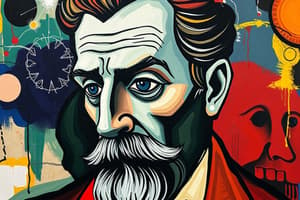Podcast
Questions and Answers
What was the notable feature of Freud's office as remembered by Sergei Pankejeff?
What was the notable feature of Freud's office as remembered by Sergei Pankejeff?
- It was decorated with modern art.
- It resembled a traditional medical clinic.
- It reminded him of an archaeologist’s study. (correct)
- It looked like an expert's library.
Which aspect of Egyptian culture did Freud associate with infantile bisexuality?
Which aspect of Egyptian culture did Freud associate with infantile bisexuality?
- The polytheistic nature and mother-child relationships. (correct)
- Its monotheistic tendencies.
- The emphasis on physical beauty.
- The rigid social hierarchy.
In which of Freud's works did he extensively engage with the subject of Egypt?
In which of Freud's works did he extensively engage with the subject of Egypt?
- Three Essays on the Theory of Sexuality.
- Civilization and Its Discontents.
- The Interpretation of Dreams.
- Moses and Monotheism. (correct)
What did Freud collect that he described as an 'addiction'?
What did Freud collect that he described as an 'addiction'?
What does the bronze amulet of the goddess Mut signify in Freud's writings?
What does the bronze amulet of the goddess Mut signify in Freud's writings?
How does Freud's interpretation of Egyptian monotheism differ from the perspective provided by Petrie's artefacts?
How does Freud's interpretation of Egyptian monotheism differ from the perspective provided by Petrie's artefacts?
What aspect of Akhenaten's representation does the limestone statuette challenge in Freud's writings?
What aspect of Akhenaten's representation does the limestone statuette challenge in Freud's writings?
Which Egyptian deity mentioned was characterized as embodying both sensuality and intellect?
Which Egyptian deity mentioned was characterized as embodying both sensuality and intellect?
What significant tension is highlighted by Freud's copy of the Philippson Bible?
What significant tension is highlighted by Freud's copy of the Philippson Bible?
What is indicated by the juxtaposition of Freud's falcon-headed figurine and his childhood nightmare?
What is indicated by the juxtaposition of Freud's falcon-headed figurine and his childhood nightmare?
Flashcards are hidden until you start studying
Study Notes
Sigmund Freud's Fascination with Ancient Egypt
- Freud's analysis of Sergei Pankejeff, known as the 'Wolf Man,' highlighted Freud's extensive collection of Egyptian antiquities, likening his office to an archaeologist's study.
- Freud collected approximately 600 Egyptian items, showcasing his deep fascination, rivaling his interest in the Greco-Roman era.
- The Freud Museum's exhibition features artifacts that emphasize the symbolic significance of Egypt within Freud’s psychoanalytic framework, particularly concerning unconscious processes.
Dual Meanings of Egypt in Freud's Works
- Ancient Egyptian culture symbolizes the archaic, pre-Oedipal world, representing themes of infantile bisexuality and the bond between mother and child.
- The bronze amulet of goddess Mut and various mother-child pairs in Freud’s collection illustrate this maternal connection.
- Freud's complex relationship with female sexuality is symbolized in Jean-Auguste-Dominique Ingres’s depiction of the sphinx, embodying dangerous female sexuality.
Moses and Monotheism
- Freud's significant engagement with Egypt occurs in "Moses and Monotheism" (1939), proposing that Moses was an Egyptian follower of Akhenaten, not a Jew.
- This work presents Egypt not as a land of sensual pleasures but as a source of Judaism’s rational, universalizing religion associated with masculine reason.
Flinders Petrie and the Archaeological Context
- The exhibition features items from Flinders Petrie, a significant British Egyptologist, enhancing discussions on monotheism versus polytheism and other binaries in Freud’s theories.
- Petrie's excavation of Akhenaten’s capital, Amarna, revealed the pharaoh’s monotheistic reign and challenged Freud's views on masculinity and femininity through artefacts.
Freud's Personal Engagement with Artifacts
- Freud cherished a marble statuette of Thoth, the god of intellect and writing, reflecting both the sensual and intellectual appeal of ancient artifacts.
- His housekeeper noted Freud’s tactile engagement with items, suggesting a profound personal connection to his collection.
The Philippson Bible
- Freud's copy of the Philippson Bible influenced his early exposure to Egypt, juxtaposing Jewish texts with illustrations of Egyptian deities, sparking a creative tension between monotheism and polytheism.
- The bible’s prohibition of 'graven images' contrasted with the visual representations of Egyptian gods, illustrating Freud’s conflicting perspectives on spirituality.
Exhibition Insights
- The exhibition aims to convey the nuanced significance of Egyptian artifacts in Freud's life and theories, emphasizing their influence on his psychological constructs.
- Items are thoughtfully curated to showcase the interplay between Freud's personal experiences, collecting impulses, and theoretical formulations, highlighting Egypt's shaping impact on his thought processes.
Studying That Suits You
Use AI to generate personalized quizzes and flashcards to suit your learning preferences.




